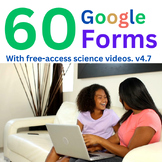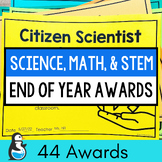33 results
Higher education chemistry webquests
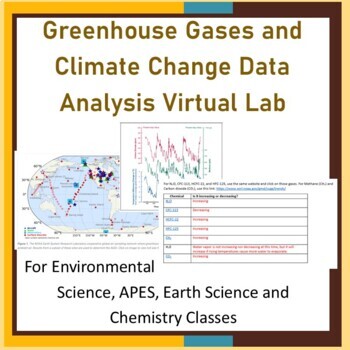
Greenhouse Gases and Climate Change Data Analysis Virtual Lab
Updated links as of March 2022. This lab for in-person or distance learning uses a variety of data from NOAA and other websites to help your students understand greenhouse gases, where they are found and whether they are increasing or decreasing. Then, students analyze data about the effects of climate change with real-time data about temperature, precipitation and other data. Then, students delve into longer term data including ice-core data.This lab walks students through each graph and data s
Subjects:
Grades:
9th - 12th, Higher Education
Types:
NGSS:
HS-ESS3-3
, HS-ESS3-1
, HS-ESS3-5
Also included in: AP Environmental Science Unit 9 Bundle

Ozone Depletion Data Analysis 5E Lab-- Computer Lab
Use this inquiry lab with in-person or distance learning students. 7 pages for students with key included. This lab is not a simulation, but rather looking at data from various sources.Time: 2-4 days (90 minutes to 3 hours depending on level of students and whether you choose to assign the elaborate and evaluate)Students use real online data to determine trends in ozone depletion around the globe and trends in ozone-depleting chemicals along with the science and current trends.Use with Environme
Subjects:
Grades:
9th - 12th, Higher Education
Types:
NGSS:
HS-ESS3-6
, HS-ESS3-4
Also included in: AP Environmental Science Unit 9 Bundle
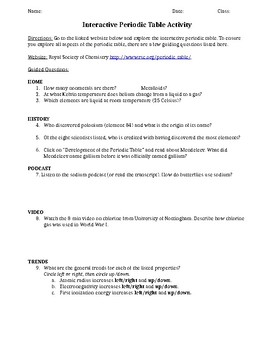
Interactive Periodic Table WebQuest
This assignment guides students through properties of the periodic table such as organization (groups, periods, group names, phases), history (Mendeleev, Moseley, and more), element discovery, videos on specific elements and their reactivities and unique properties, and periodic trends (electronegativity, atomic radius, ionization energy and more). The assignment is designed to help students explore on their own while providing an opportunity for accountability. Great for differentiating instruc
Subjects:
Grades:
7th - 12th, Higher Education, Adult Education
Types:
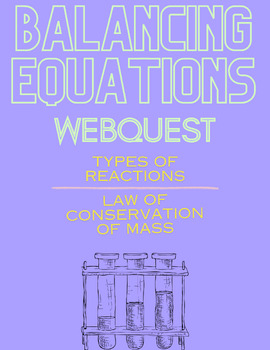
Balancing Equations WebQuest
Teacher Instructions This activity can be used as a review of balancing equations or as an initial activity after notes on balancing equations. Students will need to be able to name compounds to complete station six. If you have not taught naming compounds you can still have your students complete stations 1-5.Student WorksheetsPages 2-7 are the student worksheets. You will need to print these and this is what the students will write on as they go from station to station. If you want the student
Subjects:
Grades:
6th - 12th, Higher Education, Adult Education
Types:
NGSS:
HS-PS1-7
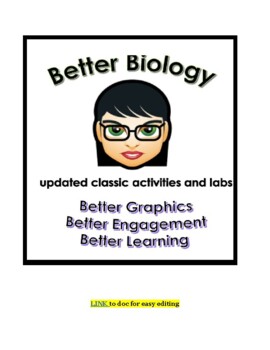
Virtual Lab/Online Learning: Gram Stain Bacteria Cells (Honors, AP, College)
Better Biology loves this lab and it is especially suited for honors and collegiate students.The simulation gives students as close to the real experience they would experience if actually performing the Gram stain technique. The virtual lab requires them to follow procedure steps precisely in order to obtain positive results. Whether used to augment the study of cells or used as part of a microbiology unit, the virtual lab is a great tool. Better Biology has used the lab, both as an in-class di
Subjects:
Grades:
9th - 12th, Higher Education, Adult Education
Types:

Computer Model Analysis - Water Changes in the Water Cycle & Thermal Energy
This Google Form guides students in learning about thermal energy transfer and the particulate nature of matter. Using a computer model, students record observations on the changes in kinetic energy of water molecules. This is the link to the computer model used: https://phet.colorado.edu/sims/html/states-of-matter-basics/latest/states-of-matter-basics_en.htmlStudents are guided in connecting key concepts to phenomena - such as melting and freezing water, cloud formation, and steps in the water
Subjects:
Grades:
5th - 12th, Higher Education, Adult Education, Staff
Types:
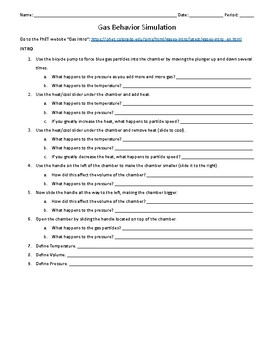
Intro to Gas Behavior - Simulation (with Key)
Use this handout to introduce how gases behave alongside a PhET simulation. Students will learn about conceptual gas behavior, develop personal definitions of volume, pressure, and temperature, as well as explore the following gas laws: Boyle's, Charles', Gay-Lussac's, and Combined Gas Law. Activity is self-guided and a great start to your gas unit.
Subjects:
Grades:
6th - 12th, Higher Education, Adult Education
Types:
Also included in: Gas Laws Bundle

PCR Click & Learn (interactive google slides)
Interactive Google Slide presentation and worksheet that takes students through the purpose and steps of PCR and includes components necessary for the reaction to take place (Master Mix) at their own pace. The interactive slide deck can be assigned as an awesome introduction to PCR before diving into labs, activities, or more detailed learning. Alternative to the great (but no longer active) PCR interactive from Learn.Genetics. Take a look at the preview for a sneak peak at PART of the slide dec
Subjects:
Grades:
9th - 12th, Higher Education, Adult Education, Staff

Webquest Virtual Lab Atomic Structure, States of Matter, Density Simulations
Students use simulations to explore key concepts in Physical Science: atomic structure, the particulate nature of matter, and density. Students are guided with detailed questions and apply key vocabulary. This webquest uses multiple webpages (below). Take your students on a virtual field trip to see the particulate nature of matter!This is an editable (.rtf) file. Links needed: Build an Atom Basics - on Chromebook:https://phet.colorado.edu/en/simulation/build-an-atomor Build an Atom Basics - o
Subjects:
Grades:
6th - 12th, Higher Education, Adult Education
Types:
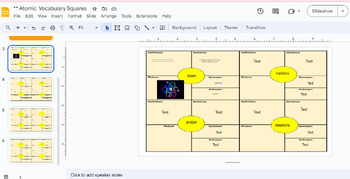
Atom Unit Vocabulary Words and Definitions Squares
This document is excellent at the start of the atomic unit to ensure students understand the academic vocabulary—an excellent resource for second language learners taking chemistry. The product contains online activities for the students to do. Build Bohr modelsAtomic Structure TutorialsVideo on Edpuzzle or YouTube Rutherford Model.Vocabulary Squares on Slide
Subjects:
Grades:
4th - 12th, Higher Education, Adult Education
CCSS:
NGSS:
HS-PS1-8
, HS-PS1-1
, MS-PS1-1
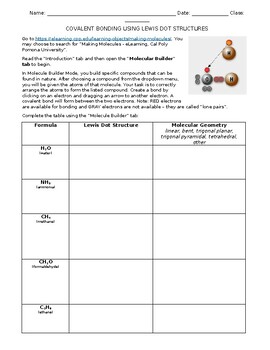
Drawing Covalent Compounds WebQuest
Students will use a linked website to walk them through how to draw Lewis Dot diagrams in covalently bonded molecules. This assignment is designed for students to complete on their own or in a computer lab with minimal instruction from the teacher. Lewis Dot diagrams can be very complex and there are a variety of exceptions, but not in the handout. Students typically find this assignment to be easy.
Subjects:
Grades:
7th - 12th, Higher Education, Adult Education
Types:
Also included in: Drawing Covalent Compounds Bundle
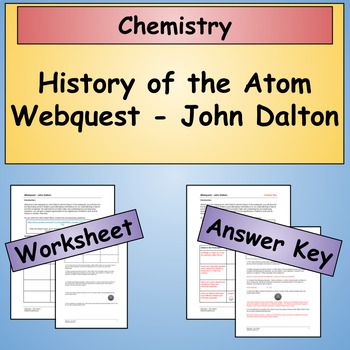
WebQuest - John Dalton - History of the Atom
Introducing a WebQuest on John Dalton's Atomic Theory. This thoughtfully designed resource provides an in-depth exploration of Dalton's groundbreaking contributions to our understanding of the atom.The WebQuest begins with a video that introduces students to Dalton's theories and postulates. As they watch the video, students actively participate by filling in a carefully structured table.Following the video, students will answer a series of questions based on his postulates. These questions not
Subjects:
Grades:
9th - 12th, Higher Education
Types:
NGSS:
HS-PS1-1
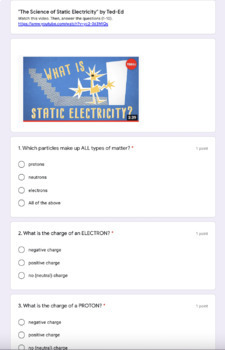
TedEd Video Qs -The Science of Static Electricity
This Google Form guides students in learning about static electricity. Students watch a TedEd YouTube video on static electricity, parts of an atom, and insulators versus conductors. This is the video link: https://www.youtube.com/watch?v=yc2-363MIQsTen questions (with automatic grading, instant feedback, and automatic scoring) provide students the opportunity to understand key concepts in Matter & Interactions units. Real world examples are included, including a discussion of lightning stor
Subjects:
Grades:
4th - 12th, Higher Education, Adult Education, Staff
Types:
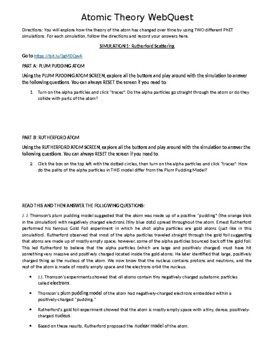
Atomic Theory WebQuest
Students will use two PhET Simulations to explore (1) how Thomson's Plum Pudding Model of the atom differs from Rutherford's Nuclear Model of the atom and (2) how Bohr Models are used to make predictions about atomic structure. Isotopes are also briefly explored. This can be used for distance learners and in-person traditional settings or hybrid-style classrooms. Can typically be completed within a 45-minute period but can be used in a 90-minute block with additional resources.
Subjects:
Grades:
7th - 12th, Higher Education, Adult Education
Types:
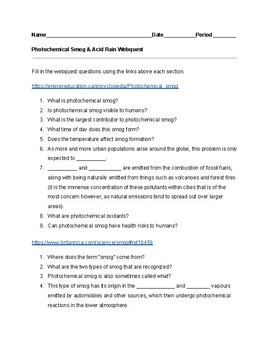
Photochemical Smog & Acid Rain Webquest
This webquest goes along with Unit 7 of the AP Environmental Science Curriculum. It lets students explore these concepts on their own time. It makes for a great homework assignment pre-lecture, substitute assignment, or in class guided work time.
Subjects:
Grades:
9th - 12th, Higher Education
Types:

Google Expedition Virtual MOLECULES WebQuest with Answer Key
Use the Google Expedition Virtual MOLECULES WebQuest to experience 3D images while being guided through the virtual google expedition. Students will fill in the blank as they go along with the expedition. This is a 6-page webquest that will take the majority of class. This is best for chemistry students. An answer key is provided.
Subjects:
Grades:
9th - 12th, Higher Education, Adult Education
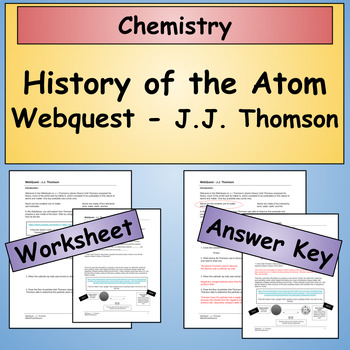
WebQuest - Niels Bohrs - History of the Atom
Introduce your students to the captivating world of atomic structure with our Niels Bohr's Atomic Model WebQuest! This two-page educational resource serves as an ideal introduction to electron energy, orbits, and spectral lines in atomic theory. Designed for middle and high school students, this product offers a seamless integration into your science curriculum.Through carefully selected links to a captivating video and an informative article, students will explore the foundations of Bohr's ato
Subjects:
Grades:
9th - 12th, Higher Education
Types:
NGSS:
HS-PS1-1
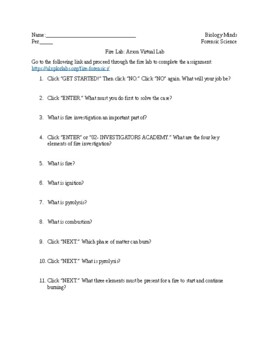
Fire and Arson Virtual Lab Webquest
Students complete the Fire Virtual Lab to explore an Arson Investigation.
Subjects:
Grades:
9th - 12th, Higher Education
Types:
Also included in: Forensic Science and Criminalistics Virtual Lab Webquest Bundle

WebQuest - Ernest Rutherford - History of the Atom
Introducing a WebQuest on Ernest Rutherford's Atomic Theory. This thoughtfully designed resource provides an in-depth exploration of Rutherford's ground breaking gold foil experiment, and how it led to the discover of the nucleus and our modern understanding of the atom.The WebQuest begins with a reference to Daltons and Thomson's atomic theories. Then it moves to a video that reviews Rutherford's experiment and the conclusions he drew from it. While watching, students will answer questions and
Subjects:
Grades:
9th - 12th, Higher Education
Types:
NGSS:
HS-PS1-1

Carbon Cycle Webquest
This webquest is based on a webpage from the UCAR Center for Science Education's website (link: https://scied.ucar.edu/learning-zone/earth-system/biogeochemical-cycles). The activity includes 14 questions (plus one bonus question) that walk students through how carbon is cycled through Earth's atmosphere, biosphere, geosphere, and hydrosphere. I usually assign this activity when I am teaching students about the Law of Mass Conservation - the webquest helps explain to students that even though
Subjects:
Grades:
9th - 12th, Higher Education, Adult Education
Types:

WebQuest - J.J. Thomson - History of the Atom
Introducing a WebQuest on J.J. Thomson's Atomic Theory. This thoughtfully designed resource provides an in-depth exploration of Thomson's groundbreaking cathode ray tube experiment, and how it led to the discover of the electron and our modern understanding of the atom.The WebQuest begins with a reference to Dalton's atomic theory and its core postulate that Thomson proved wrong. Then it moves to a video that introduces students to Thomson's cathode ray experiment and how he discovered the elec
Subjects:
Grades:
9th - 12th, Higher Education
Types:
NGSS:
HS-PS1-1

Drawing Covalent Compounds Bundle
This bundle provides space for students to practice drawing Lewis Diagrams of covalent molecules. One assignment incorporates single bonds only while the other assignment builds on their understanding to include double and triple bonds. They also include sections that review naming ionic and molecular compounds. This bundle begins exploring the concept of VSEPR (valence shell electron pair repulsion) theory by having students identify how many atoms are attached to the central atom and the numbe
Subjects:
Grades:
7th - 12th, Higher Education, Adult Education
Types:
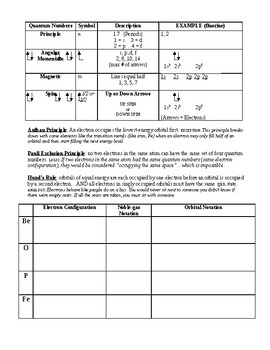
Electron Configuration and Orbital Notation
CHEMISTRY: Students will review Quantum Mechanics by learning Aufbau Principle, the Pauli Exclusion Principle, and Hund's Rule. Students will also practice writing electron configurations, noble gas notations, and orbital notations. A WebQuest worksheet is also attached to help students visualize the 3D orbitals.
Subjects:
Grades:
7th - 12th, Higher Education, Adult Education
Types:
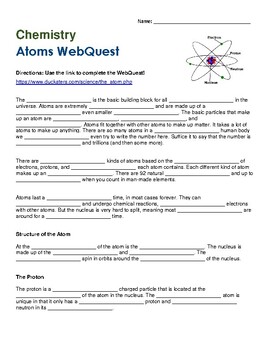
Atoms Chemistry WebQuest
Use the link provided to complete the WebQuest on Atoms in Chemistry.
Subjects:
Grades:
7th - 12th, Higher Education, Adult Education
Showing 1-24 of 33 results

